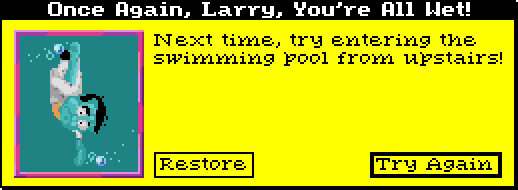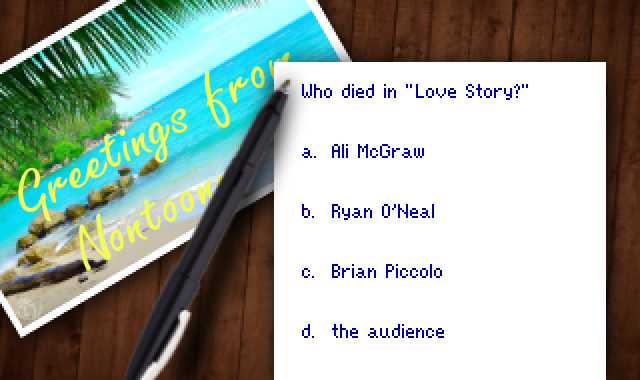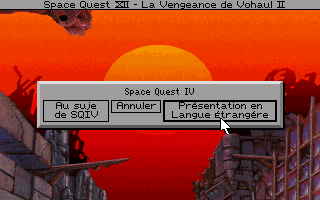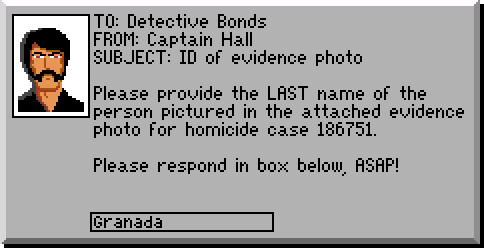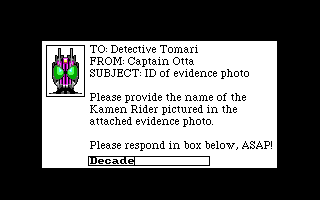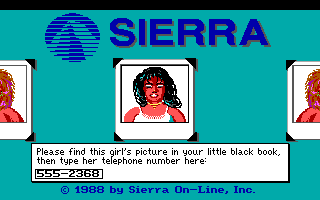“Interesting. I wonder if this is related to the “BOTH” button that got cut in SQ4.” — @ATMcashpoint
I don’t know about the both button that ScummVM adds to some SCI games, but there’s quite literally no way it could work by just adding a third button state. There’s a fair bit of script logic that’d need to be overhauled. Here’s why that is, and here’s how I did it in The Dating Pool.
I could have used the SCI Companion template game to compare against and document, but to be honest it’s a bit of a mess, as you could expect from a decompilation. The leaked system scripts are much neater to work with, even though the actual script code is basically identical.
Original Messager.sc:
(method (sayNext theMod theNoun theVerb theCase theSeq &tmp aTalker [theBuf 200] msgkey)
; If we were called with arguments, grab the text for that entry.
; If not, grab the next entry in the sequence.
(if argc
(= aTalker (Message msgGET theMod theNoun theVerb theCase theSeq @theBuf))
else
(= aTalker (Message msgNEXT @theBuf))
)
; If we have voice enabled, allocate space and grab the entry's tuple.
; This block is missing in SQ4CD.
(if (& gMessageType CD_MSG)
(= msgkey (Memory memALLOC_CRIT 12))
(Message msgLAST_MESSAGE msgkey)
)
(if (and aTalker
(or (not lastSequence)
(and lastSequence
(<= curSequence lastSequence)
)
)
)
; Look up the Talker (or Narrator) by number.
; aTalker was a number, but now it'll be an object pointer.
(= aTalker (self findTalker: aTalker))
(if (!= aTalker -1)
(talkerSet add: aTalker)
; Now let our Talker handle the rest.
(if (& gMessageType CD_MSG)
(aTalker
modNum: theMod,
say: msgkey self ;<-- pass ONLY the tuple
)
else
(aTalker
modNum: theMod,
say: @theBuf self ;<-- pass ONLY the string
)
)
; In SQ4, we just always pass only @theBuf. There's some major
; voodoo involved in getting it to work.
(++ curSequence)
)
; Cutting a bit of irrelevant fastcast voodoo
)
; Dispose of the space we allocated for the voice tuple, if needed.
(if (& gMessageType CD_MSG)
(Memory memFREE msgkey)
)
)
Catdate’s Messager.sc:
; Exactly the same as in the template BUT...
(if (!= aTalker -1)
(talkerSet add: aTalker)
; Pass both the buffer AND the tuple, no matter our settings.
; That does mean that msgkey may be null, but say won't use it in
; that case anyway.
(aTalker
modNum: theMod
say: @theBuf msgkey
)
(++ curSequence)
)
In SQ4CD, the Narrator has extra noun, verb, and sequence properties that get set to allow the text to work. It’s really quite a bit of a mess, and my hat’s off to whoever on the ScummVM team got that Both mode to work. I was going to document it but got lost trying, it’s that wild.
On to the Narrator and by extension Talker!
Original Talker.sc:
(method (say theBuf whoCares)
(if theIconBar (theIconBar disable:))
(if (not initialized) (self init:))
(= caller
(if (and (> argc 1) whoCares)
whoCares
else
null
)
)
; Figure out what to do with the message.
; Note that in one case, theBuf is a string...
(if (& gMessageType TEXT_MSG)
; (method (startText theBuf &tmp strLength)
(self startText: theBuf)
)
; ...but in the other it's a tuple!
(if (& gMessageType CD_MSG)
; (method (startAudio theKeys &tmp m n v c s)
(self startAudio: theBuf)
)
; cut a bit...
; start___ will have set ticks to the length
; of the string or recording. We add one more
; second regardless.
(= ticks (+ ticks 60 gameTime))
(return true)
)
Catdate’s Talker.sc:
; much the same, but
(method (say theText theAudio whoCares)
; ...
(if (& gMessageType TEXT_MSG)
(self startText: theText)
)
(if (& gMessageType CD_MSG)
(self startAudio: theAudio)
)
; ...
)
Now, this works fine. If I record a quick bit of gibberish, then load up the game, switch to Both, and click, I get a perfectly readable message and hear my gibber. But if I were to revert my little change and use the original code…

That’s what we in the business call mistaking a bunch of numbers for a valid string. I specifically get this result because the first value in the tuple is the module number, which is 110 (0x6E ‘n‘) in this case, and all numbers in SCI are 16-bit so there’s a terminating null right after.
What’s funny is that after all this, I can’t see how SQ4 is supposed to support Both mode, and ScummVM only needs to add that third button state. There is no patch to adjust the script, and I can’t for the life of me figure out how this would work:
(method (say theVoodoo whoCares &tmp newEvent)
; ...
(if (& gMessageType TEXT_MSG)
; Note: noun, tVerb, and tSequence are properties. theVoodoo is now "case".
(self startText: modNum noun tVerb theVoodoo tSequence &rest)
)
(if (& gMessageType CD_MSG)
(self startAudio: theVoodoo)
)
; ..
)
The weird part is that I can’t find anywhere those properties are set.
…At least with the KQ6/LB2 patches they actually do overhaul quite a bit of the scripts’ logic, which are otherwise just the same system scripts as above. Not the way I did it for my game, but clearly in a way that works out.
